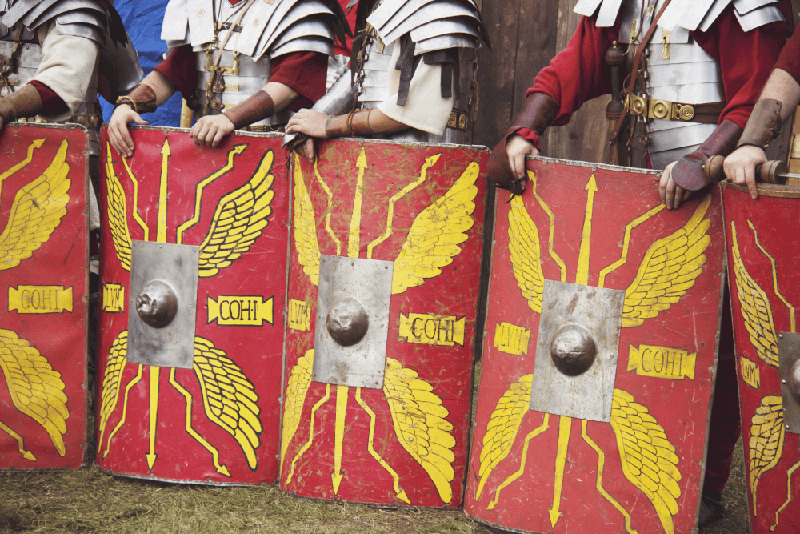Roman shields were called scutum and were mostly made of wood. They were made to be both strong and light. Usually, leather was used to cover the wood, which helped protect it and make the shield stronger. Also, the front of the shield was often strengthened with metal, like bronze or iron, to give it even more protection.
The scutum was made so that it could be used to hold spears, swords, and arrows. The shield was big enough to cover a large part of the body, making it hard for attackers to hit a legionnaire who was behind it. Also, the scutum was made so that it could be used with other shields to make a wall that was hard for attackers to break through. Lastly, the shield was made so that it could be used to both blocks and hit, so legionnaires could use it to defend themselves and fight back if they had to.
The scutum was a standard piece of equipment for Roman soldiers. It was given to every legionnaire in the army & they did not have to buy it on their own. The shield could be different sizes and weights, but a typical scutum was about 3 to 4 feet tall and 2 to 2.5 feet wide. The shield’s exact weight depended on what it was made of, but it was usually between 10 and 15 pounds.
The color of the scutum also changed, but it was usually painted red or a reddish-brown color. This wasn’t done to send a message; instead, it was done because red paint was easy to find and cheap in the Roman Empire.
There were many battles in which the scutum was used by the Roman army, and it’s difficult to identify a single battle in which the scutum was solely responsible for the victory. However, one of the most famous battles in which scutum played a crucial role was the Battle of Alesia in 52 BCE.
During the Gallic Wars, Julius Caesar’s army faced a Gallic force led by Vercingetorix that had taken refuge in the fortified town of Alesia. Caesar laid siege to the town and constructed a series of fortifications to prevent reinforcements from entering. Vercingetorix’s army eventually arrived and attempted to break the siege, resulting in a massive battle.
During the battle, the Roman army used the scutum in their traditional formation, known as the testudo or tortoise. This formation involved overlapping the shields of multiple soldiers to create a wall of protection that was difficult for attackers to penetrate. The Roman soldiers used their scutum to protect themselves from the Gallic weapons, while their swords and javelins were used to attack the enemy.
The use of the scutum in the testudo formation played a critical role in the Roman victory at Alesia. The fortifications built by Caesar prevented the Gallic army from entering the town, and the Roman soldiers were able to withstand the attacks of the Gallic forces thanks to their scutum. Eventually, Vercingetorix was forced to surrender, and the Roman army emerged victorious.
While the scutum was not solely responsible for the victory at Alesia, its use in the testudo formation played a crucial role in the Roman victory.

